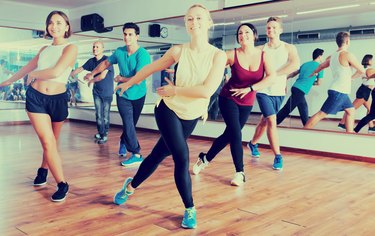
A curtsy lunge adds pizzazz to the standard linear forward, or backward, lunge. This crossed-over lunge helps to incorporate new leg muscles into the lunge position, giving you toned inner and outer thighs.
How It Works
Video of the Day
A curtsy lunge, sometimes called a curtsy squat, very much resembles the move it's named after: The Curtsy. Proper execution of the exercise ensures you hit the muscles safely and effectively.
Video of the Day
How To: Start by standing with your feet shoulder-width apart and your hands on your hips for stability. Use your left leg to take a large step back and across to the right -- you'll cross behind the right leg. Squat so your right thigh is parallel with the ground. Push off with your left leg to straighten your legs and return to your starting position. For an added challenge, hold hand weights in each hand during the exercise.
Read More: 22 New Lunges to Supercharge Leg Day
Quadriceps
Your quadriceps muscles are the four muscles located at the front of your thigh. You activate these muscles when you lunge, lengthening and shortening them as you squat and stand, respectively. The quads are activated during a curtsy lunge, particularly in your front leg. You use these muscles to help straighten your legs when you return from the cross-over to the starting position.
Gluteals
The curtsy lunge is sometimes called the glute-activation lunge. The gluteal muscles include the gluteus maximus, gluteus medius and gluteus minimus. The gluteus minimus muscles also are known as the hip abductors because they are used to pull the leg toward your body. These muscles sit on the side of your buttocks.
The curtsy lunge activates the glutes in a unique way because it targets these abductor muscles more so than does a standard lunge, which targets mostly the gluteus maximus. A curtsy lunge also activates the gluteus maximus and gluteus medius.
Read More: Exercises to Target the Gluteus Minimius
Soleus/Gastrocnemius
The soleus and gastrocnemius muscles are located in the back of the lower leg and are often collectively referred to as the calf muscles. In the curtsy lunge, these muscles act as the stabilizers, particularly in the leg located behind you. When you push off on this leg to return to your starting position, you're using your calf muscles. Alternating the exercise between your right and left leg ensures you tone these muscles evenly.